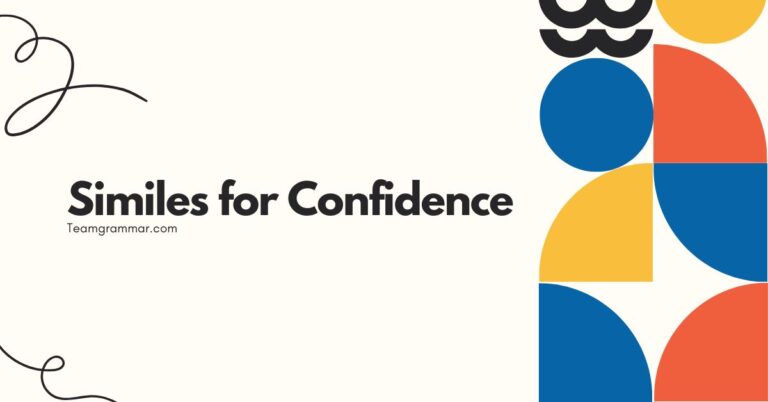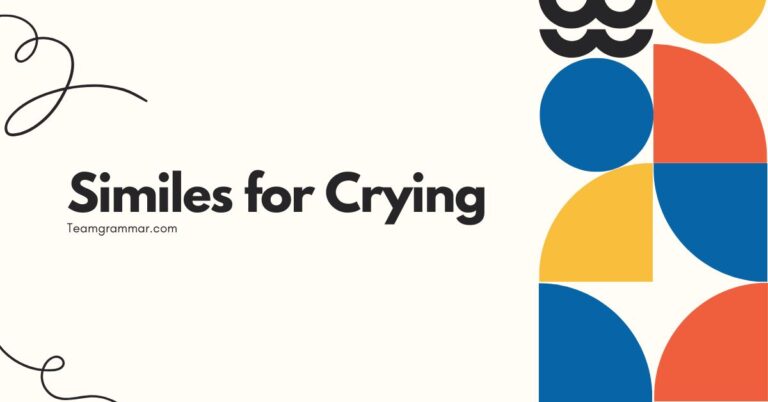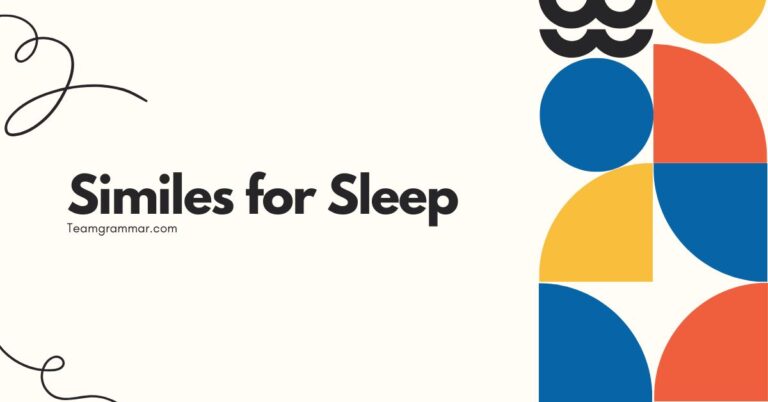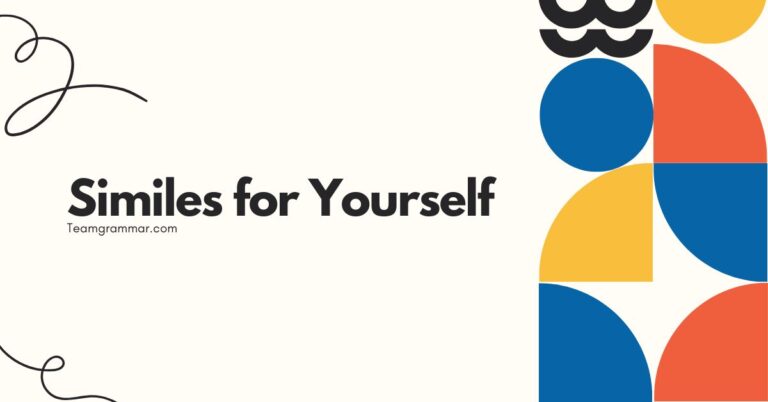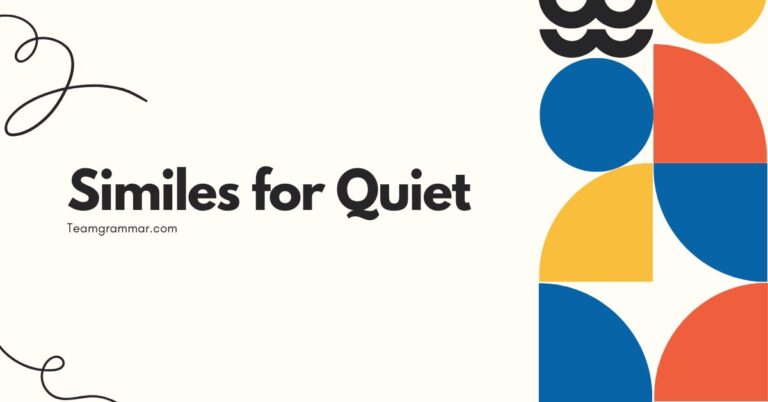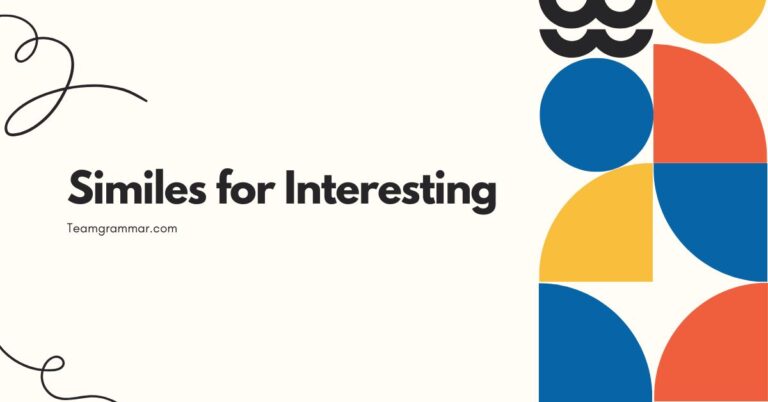43 Similes for Education: Enhancing Learning Through Comparison
Similes are powerful tools that can significantly enhance the educational experience. By drawing comparisons between different concepts, similes help students grasp complex ideas more easily and make learning more engaging.
Understanding how to use and interpret similes is crucial for both students and educators, as it fosters a deeper understanding and appreciation of language and knowledge across various subjects.
This article provides a comprehensive guide to similes, covering their definition, structure, types, usage, and application in education. Whether you’re a student looking to improve your writing skills or a teacher seeking innovative ways to explain challenging topics, this guide will equip you with the knowledge and tools you need to effectively use similes in the classroom and beyond.
This guide is beneficial for students, teachers, educators, and anyone interested in understanding and utilizing similes to enhance communication and comprehension. By mastering the art of simile, learners can unlock a new level of understanding and creativity in their academic pursuits.
Table of Contents
- Definition of Simile
- Structural Breakdown of Similes
- Types of Similes
- Examples of Similes
- Usage Rules for Similes
- Common Mistakes When Using Similes
- Practice Exercises
- Advanced Topics in Similes
- Frequently Asked Questions (FAQ)
- Conclusion
Definition of Simile
A simile is a figure of speech that compares two different things using the words “like” or “as.” The purpose of a simile is to create a vivid image or make a concept more understandable by relating it to something familiar. Similes are essential tools in both writing and speaking, adding depth, clarity, and creativity to communication.
In the realm of figurative language, similes are classified as a type of comparison. They function to illuminate and clarify by drawing parallels between dissimilar objects or ideas.
The context in which a simile is used can vary widely, from literature and poetry to everyday conversation and educational materials.
Similes differ from metaphors, which state that one thing *is* another, whereas similes only suggest a resemblance. For example, “The student is a sponge” is a metaphor, while “The student is like a sponge” is a simile.
The use of “like” or “as” is the defining characteristic of a simile.
Structural Breakdown of Similes
The basic structure of a simile consists of three main components: the two things being compared (the subject and the object of comparison) and the word that connects them (“like” or “as”). Understanding this structure is crucial for both creating and interpreting similes effectively.
Components of a Simile
- Subject: The thing being described or compared.
- Connecting Word: The word “like” or “as” that establishes the comparison.
- Object of Comparison: The thing to which the subject is being compared.
For instance, in the simile “The teacher is as patient as a saint,” the teacher is the subject, “as” is the connecting word, and a saint is the object of comparison. This structure highlights a specific quality (patience) that the teacher shares with a saint.
Patterns in Similes
Similes often follow specific patterns to enhance their impact and clarity. Common patterns include:
- Subject + is like/as + Object of Comparison: This is the most common and straightforward pattern.
- As + Adjective + as + Object of Comparison: This pattern emphasizes a particular quality shared by the subject and object.
Understanding these patterns can help you construct more effective and creative similes. For example, “The explanation was as clear as crystal” follows the second pattern, emphasizing the clarity of the explanation.
Types of Similes
Similes can be categorized based on their purpose and the type of comparison they make. Recognizing these categories can help you choose the most appropriate simile for a given context.
Descriptive Similes
Descriptive similes are used to provide a vivid description of something by comparing it to something else. These similes often appeal to the senses, creating a strong mental image.
Explanatory Similes
Explanatory similes are used to clarify a concept or idea by relating it to something more familiar. These similes are particularly useful in education for explaining complex topics.
Humorous Similes
Humorous similes are used to create a funny or ironic effect by comparing things in an unexpected or absurd way. These similes can add levity to a text or conversation.
Emphatic Similes
Emphatic similes are used to emphasize a particular quality or characteristic by comparing it to something that strongly embodies that quality. These similes add force and impact to the statement.
Examples of Similes
The following sections provide extensive examples of similes, organized by category. These examples illustrate the versatility and power of similes in enhancing communication and understanding.
Descriptive Similes Examples
Descriptive similes paint a vivid picture in the reader’s mind. They often appeal to the senses, making the description more engaging and memorable.
The table below provides several examples of descriptive similes:
| Simile | Explanation |
|---|---|
| The sky was as blue as the ocean. | Compares the color of the sky to the color of the ocean, emphasizing its blueness. |
| Her smile was like sunshine. | Compares her smile to the warmth and brightness of sunshine. |
| The music was as smooth as silk. | Compares the smoothness of the music to the texture of silk. |
| The coffee was as bitter as gall. | Compares the bitterness of the coffee to the extreme bitterness of gall. |
| The snow was like a soft blanket. | Compares the softness and coverage of the snow to a blanket. |
| The wind howled like a wolf. | Compares the sound of the wind to the howling of a wolf, emphasizing its intensity. |
| The stars twinkled like diamonds. | Compares the brightness and sparkle of the stars to diamonds. |
| The rain fell like tears. | Compares the falling rain to tears, suggesting sadness or emotion. |
| The grass was as green as emeralds. | Compares the color of the grass to the vibrant green of emeralds. |
| His voice was as deep as the ocean. | Compares the depth of his voice to the vastness of the ocean. |
| The cake was as light as a feather. | Compares the texture of the cake to the weightlessness of a feather. |
| The silence was like a heavy cloak. | Compares the oppressiveness of the silence to the weight of a heavy cloak. |
| The flowers smelled as sweet as honey. | Compares the fragrance of the flowers to the sweetness of honey. |
| The fire crackled like dry leaves. | Compares the sound of the fire to the crispness of dry leaves. |
| The moon was like a silver coin. | Compares the shape and color of the moon to a silver coin. |
| The river flowed like a ribbon. | Compares the flowing river to the smooth, continuous movement of a ribbon. |
| The clouds were as fluffy as cotton. | Compares the texture of the clouds to the soft, airy feel of cotton. |
| Her skin was as smooth as porcelain. | Compares the texture of her skin to the flawless surface of porcelain. |
| The fog was like a ghostly shroud. | Compares the density and appearance of the fog to a ghostly covering. |
| The city was as busy as a beehive. | Compares the activity level of the city to the constant movement in a beehive. |
Explanatory Similes Examples
Explanatory similes are used to clarify complex concepts by relating them to something more familiar. These similes are particularly useful in education, where they can help students grasp difficult ideas more easily.
The table below provides several examples of explanatory similes:
| Simile | Explanation |
|---|---|
| Learning a new language is like climbing a mountain. | Compares the process of learning a new language to the challenging but rewarding experience of climbing a mountain. |
| The scientific method is like following a recipe. | Compares the steps of the scientific method to the structured process of following a recipe. |
| Understanding the economy is like understanding the weather. | Compares the complexity and unpredictability of the economy to the weather. |
| The human brain is like a computer. | Compares the processing power and storage capacity of the human brain to a computer. |
| Memory is like a muscle. | Compares the strengthening of memory through practice to the building of muscle through exercise. |
| Solving a math problem is like solving a puzzle. | Compares the process of finding the solution to a math problem to the challenging and rewarding experience of solving a puzzle. |
| The cell is like a miniature city. | Compares the complex organization and functions of a cell to the various components of a city. |
| The heart is like a pump. | Compares the function of the heart to the action of a pump, circulating blood throughout the body. |
| The internet is like a vast library. | Compares the extensive information available on the internet to the vast collection of books in a library. |
| Teamwork is like a symphony. | Compares the coordinated effort of a team to the harmonious sound of a symphony. |
| Evolution is like a branching tree. | Compares the process of evolution to the branching pattern of a tree, illustrating the diversification of species. |
| Democracy is like a garden. | Compares the nurturing and maintenance required for a democracy to the care needed for a garden to thrive. |
| Writing a book is like building a house. | Compares the structured process of writing a book to the various stages of building a house. |
| Learning to code is like learning a new language. | Compares the process of learning to code to the acquisition of a new language, with its own syntax and vocabulary. |
| The immune system is like an army. | Compares the defensive function of the immune system to the protective role of an army. |
| A business is like a living organism. | Compares the growth, adaptation, and interconnectedness of a business to the characteristics of a living organism. |
| Physics is like the blueprint of the universe. | Compares the fundamental laws of physics to the essential design principles of the universe. |
| History is like a tapestry. | Compares the interconnected events and narratives of history to the woven threads of a tapestry. |
| Love is like a plant. | Compares the nurturing and care required for love to the cultivation of a plant. |
| Friendship is like a shelter in a storm. | Compares the support and security of friendship to the protection offered by a shelter during a storm. |
Humorous Similes Examples
Humorous similes add levity to writing and conversation by comparing things in an unexpected or absurd way. These similes often create a funny or ironic effect.
The table below provides several examples of humorous similes:
| Simile | Explanation |
|---|---|
| He was as nervous as a long-tailed cat in a room full of rocking chairs. | Exaggerates his nervousness by comparing it to a cat in a precarious situation. |
| She was as busy as a one-legged man in a butt-kicking contest. | Highlights her busyness in a humorous and absurd way. |
| The politician’s promises were as reliable as a screen door on a submarine. | Underscores the unreliability of the promises with a nonsensical comparison. |
| Trying to argue with him was like trying to herd cats. | Compares the difficulty of arguing with him to the near-impossible task of herding cats. |
| He was as sharp as a marble. | Ironic comparison suggesting he is not very intelligent. |
| The plan was as clear as mud. | Highlights the lack of clarity in the plan with a contradictory comparison. |
| His singing voice was like a rusty hinge. | Describes his unpleasant singing voice in a funny and vivid way. |
| She was as graceful as a newborn giraffe. | Contrasts the idea of grace with the awkwardness of a newborn giraffe. |
| The lecture was as exciting as watching paint dry. | Emphasizes the lack of excitement in the lecture with a common expression. |
| He ran like a penguin on hot coals. | Describes his awkward running style in a humorous and memorable way. |
| The coffee tasted like dirt. | Exaggerates the unpleasant taste of the coffee. |
| The instructions were as helpful as a chocolate teapot. | Highlights the uselessness of the instructions with a nonsensical comparison. |
| He was as happy as a clam at high tide. | A humorous take on a familiar saying, emphasizing his happiness. |
| Her cooking skills were as impressive as a toddler’s finger painting. | Underscores the lack of skill in her cooking with a childish comparison. |
| The traffic moved as fast as molasses in January. | Emphasizes the slow pace of the traffic with a vivid comparison. |
| He was as organized as a junk drawer. | Highlights his lack of organization with a relatable comparison. |
| The meeting was as productive as a meeting of sloths. | Emphasizes the lack of productivity with a slow-moving comparison. |
| Her fashion sense was like a clown convention. | Describes her unusual fashion sense in a funny and exaggerated way. |
| The joke was as funny as a funeral. | Ironic comparison emphasizing the lack of humor. |
| He was as subtle as a freight train. | Contrasts the idea of subtlety with the obviousness of a freight train. |
Usage Rules for Similes
Using similes effectively requires understanding certain rules and guidelines. These rules ensure that your similes are clear, appropriate, and impactful.
Clarity and Relevance
A good simile should be clear and easily understood by the audience. The comparison should be relevant and make sense in the context.
Avoid using obscure or overly complex comparisons that may confuse the reader.
Appropriateness
The simile should be appropriate for the tone and style of your writing. Avoid using humorous or informal similes in serious or formal contexts.
Consider your audience and choose similes that resonate with them.
Originality
While common similes can be effective, try to create original similes that add a unique flavor to your writing. Avoid overused or cliché similes that may sound stale or uninspired.
Consistency
Ensure that the qualities you are comparing are consistent between the subject and the object of comparison. Avoid comparing unrelated or contradictory attributes.
Common Mistakes When Using Similes
Even experienced writers can make mistakes when using similes. Being aware of these common errors can help you avoid them and improve the quality of your writing.
Confusing Similes and Metaphors
One of the most common mistakes is confusing similes with metaphors. Remember that similes use “like” or “as” to make a comparison, while metaphors state that one thing *is* another.
Incorrect (Metaphor): The student is a sponge.
Correct (Simile): The student is like a sponge.
Using Cliché Similes
Overused or cliché similes can make your writing sound unoriginal and uninspired. Try to come up with fresh and creative comparisons instead.
Cliché: As busy as a bee.
Original: As busy as a programmer debugging code.
Inconsistent Comparisons
Make sure that the qualities you are comparing are consistent and logical. Avoid comparing unrelated or contradictory attributes.
Incorrect: The car was as fast as a turtle.
Correct: The car was as fast as a rocket.
Unclear Comparisons
Ensure that your similes are clear and easily understood by the audience. Avoid using obscure or overly complex comparisons that may confuse the reader.
Unclear: The concept was like a quantum entanglement.
Clear: The concept was like a complex web of interconnected ideas.
Practice Exercises
These exercises will help you practice using similes effectively. Each exercise includes a set of questions and their corresponding answers.
Exercise 1: Identifying Similes
Identify the similes in the following sentences:
| Question | Answer |
|---|---|
| 1. The athlete was as strong as an ox. | The athlete was as strong as an ox. |
| 2. Her voice is music to my ears. | No simile present (metaphor). |
| 3. The solution was as clear as day. | The solution was as clear as day. |
| 4. He is a lion in battle. | No simile present (metaphor). |
| 5. The instructions were like a maze. | The instructions were like a maze. |
| 6. She moved as gracefully as a swan. | She moved as gracefully as a swan. |
| 7. The project was a piece of cake. | No simile present (metaphor). |
| 8. The news hit him like a ton of bricks. | The news hit him like a ton of bricks. |
| 9. Time is a thief. | No simile present (metaphor). |
| 10. The classroom was as quiet as a library. | The classroom was as quiet as a library. |
Exercise 2: Completing Similes
Complete the following similes by filling in the missing words:
| Question | Answer |
|---|---|
| 1. As brave as a __________. | As brave as a lion. |
| 2. Like two __________ in a pod. | Like two peas in a pod. |
| 3. As light as a __________. | As light as a feather. |
| 4. As blind as a __________. | As blind as a bat. |
| 5. Like a __________ in a china shop. | Like a bull in a china shop. |
| 6. As cold as __________. | As cold as ice. |
| 7. Like a __________ out of water. | Like a fish out of water. |
| 8. As stubborn as a __________. | As stubborn as a mule. |
| 9. Like watching __________ dry. | Like watching paint dry. |
| 10. As clear as a __________. | As clear as a bell. |
Exercise 3: Creating Similes
Create your own similes based on the following prompts:
| Prompt | Example Answer |
|---|---|
| 1. Describe the sound of rain. | The sound of rain is like a gentle lullaby. |
| 2. Describe the feeling of happiness. | Happiness is like a warm ray of sunshine on a cold day. |
| 3. Describe the taste of chocolate. | Chocolate tastes like a sweet, decadent dream. |
| 4. Describe the feeling of fear. | Fear feels like a cold hand gripping your heart. |
| 5. Describe the appearance of a rainbow. | A rainbow looks like a colorful bridge across the sky. |
| 6. Describe the feeling of exhaustion. | Exhaustion feels like carrying a ton of bricks. |
| 7. Describe the appearance of a starry night. | A starry night looks like a canvas sprinkled with diamonds. |
| 8. Describe the sound of a waterfall. | The sound of a waterfall is like a roaring symphony. |
| 9. Describe the feeling of love. | Love feels like a warm embrace on a chilly evening. |
| 10. Describe the taste of lemon. | Lemon tastes like a burst of sunshine in your mouth. |
Advanced Topics in Similes
For advanced learners, exploring more complex aspects of similes can further enhance their understanding and usage.
Extended Similes
Extended similes involve developing a comparison over several sentences or even paragraphs. This allows for a more detailed and nuanced exploration of the similarities between the subject and the object of comparison.
Subverted Similes
Subverted similes intentionally break the conventional rules of simile construction, often for humorous or ironic effect. These similes may compare things in unexpected or nonsensical ways.
Cultural and Contextual Considerations
The effectiveness of a simile can depend on cultural and contextual factors. A simile that resonates with one audience may not be as effective with another.
Consider your audience and the context when choosing or creating similes.
Frequently Asked Questions (FAQ)
This section addresses some common questions about similes.
- What is the difference between a simile and a metaphor?
A simile compares two things using “like” or “as,” while a metaphor states that one thing *is* another. Similes suggest a resemblance, while metaphors imply a stronger identity.
- How can similes improve my writing?
Similes add depth, clarity, and creativity to your writing by creating vivid images and making concepts more understandable. They can also make your writing more engaging and memorable.
- Are there any situations where I should avoid using similes?
Avoid using similes in situations where clarity and precision are paramount, such as in technical or scientific writing where literal language is preferred. Also, avoid using similes that are inappropriate for the tone or context of your writing.
- How can I create original and effective similes?
To create original similes, think about the qualities you want to highlight and brainstorm different things that share those qualities. Try to come up with unexpected or unusual comparisons that will surprise and delight your readers.
- What are some common mistakes to avoid when using similes?
Common mistakes include confusing similes with metaphors, using cliché similes, making inconsistent comparisons, and creating unclear comparisons. Being aware of these errors can help you improve the quality of your similes.
- Can similes be used in academic writing?
Yes, similes can be used in academic writing, but they should be used judiciously. They can be effective for explaining complex concepts or illustrating abstract ideas, but they should not be used in place of clear and precise language.
- How do I identify a simile in a text?
To identify a simile, look for comparisons that use the words “like” or “as.” The simile will connect two different things to highlight a shared quality or characteristic. For example, “The snow was as white as cotton” is a simile because it compares the color of the snow to the color of cotton using the word “as.”
- What role do similes play in poetry?
Similes are frequently used in poetry to create vivid imagery, evoke emotions, and enhance the overall aesthetic appeal. They help poets convey complex ideas and feelings in a concise and impactful way. By drawing comparisons between seemingly unrelated things, similes can add depth and richness to a poem.
- Are similes only for descriptive purposes, or can they serve other functions?
While similes are often used for descriptive purposes, they can also serve other functions, such as explaining complex concepts, adding humor, or emphasizing a particular quality. The function of a simile depends on the context in which it is used and the intention of the writer or speaker.
- How do cultural backgrounds affect the interpretation of similes?
Cultural backgrounds can significantly affect the interpretation of similes, as the familiarity and connotations of the objects or concepts being compared may vary across cultures. A simile that is effective in one culture may be confusing or even offensive in another. It is important to be aware of these cultural differences when using similes in cross-cultural communication.
- Can a simile be considered a weak form of metaphor?
Whether a simile is considered a “weak” form of metaphor is subjective and depends on the context and the writer’s intention. While metaphors create a direct identification between two things, similes offer a more nuanced comparison, allowing for a degree of separation and qualification. Some may view this as less forceful, while others may see it as more precise and versatile.
- What are some examples of similes used in famous literature?
Famous similes in literature include: “O my love is like a red, red rose” (Robert Burns), “The Raven himself is hoarse/That croaks the fatal entrance of Duncan/Under my battlements” (William Shakespeare – while not using like or as, this functions similarly to a simile), and “The sky look’d like a sheet of paper” (Henry Wadsworth Longfellow). These examples illustrate the power of similes to create vivid imagery and enhance the emotional impact of literary works.
Conclusion
Similes are valuable tools for enhancing communication and understanding in various contexts, especially in education. By mastering the art of simile, students and educators can unlock a new level of creativity and clarity in their writing and speaking.
Understanding their structure, types, and usage rules is crucial for effective application.
Remember to focus on clarity, relevance, and originality when creating similes. Avoid common mistakes such as confusing similes with metaphors or using cliché comparisons.
Practice regularly to improve your ability to craft compelling and impactful similes.
By incorporating similes into your educational materials and communication strategies, you can make learning more engaging, accessible, and memorable for students of all ages. Embrace the power of comparison and watch your communication skills soar!


